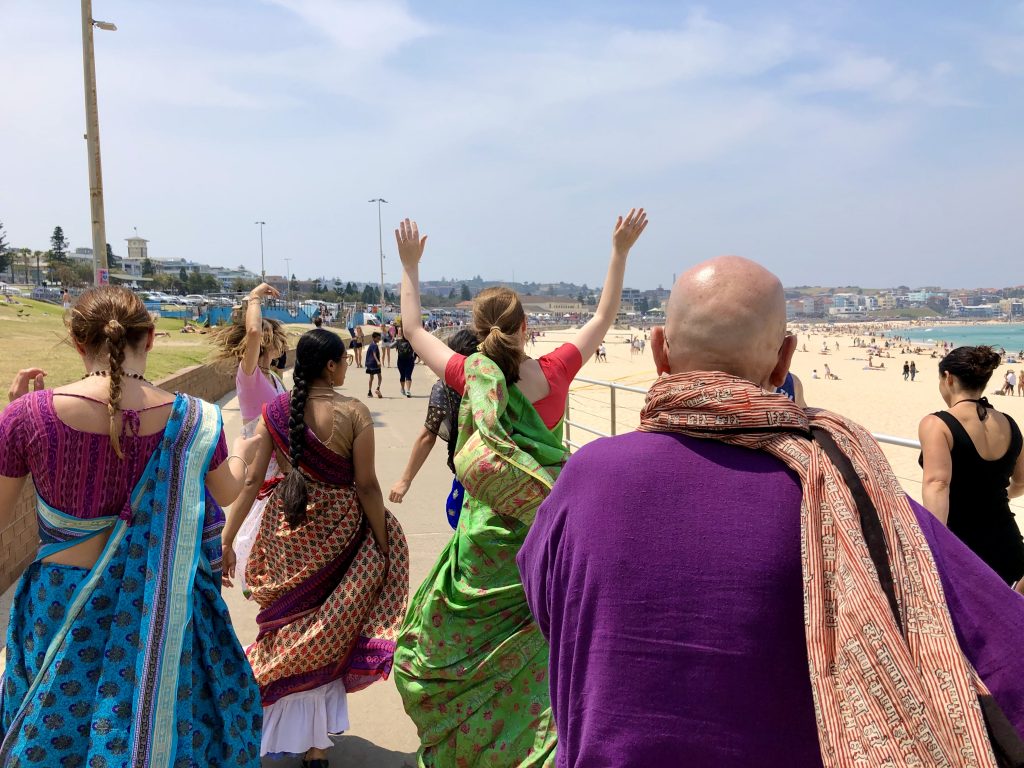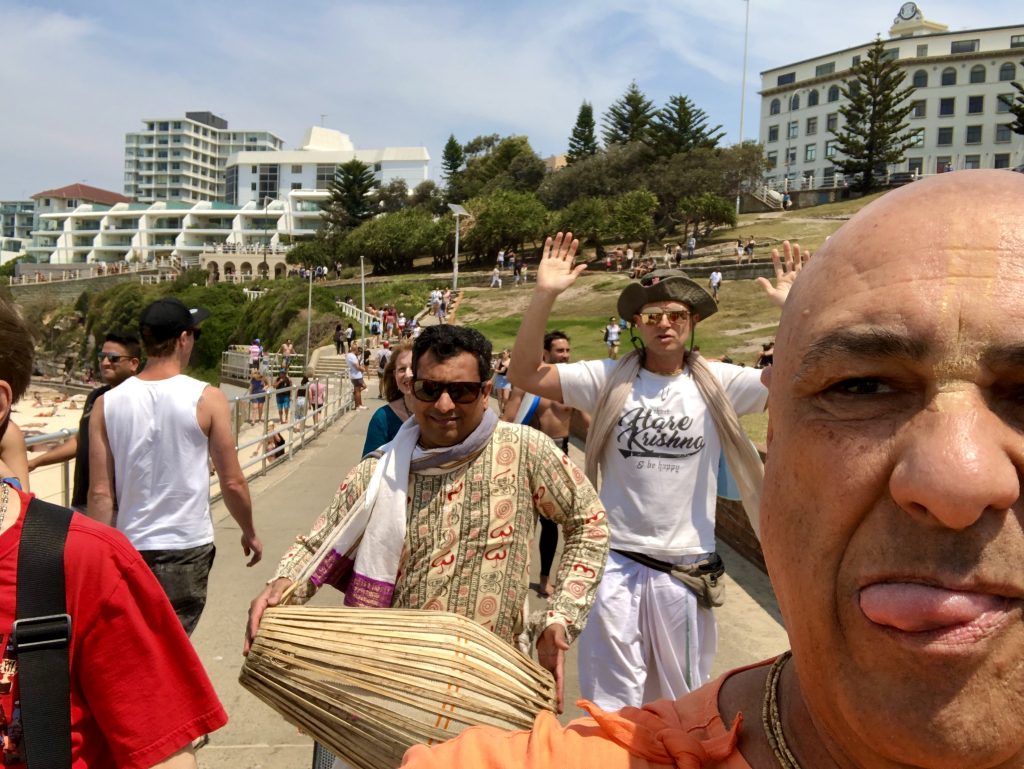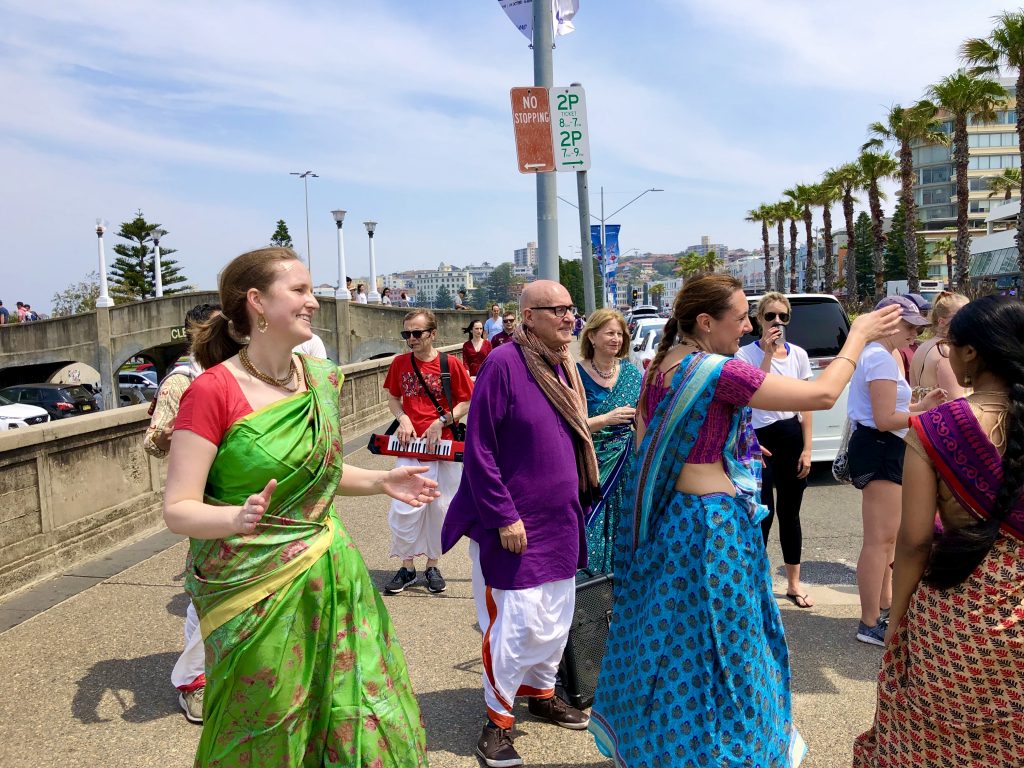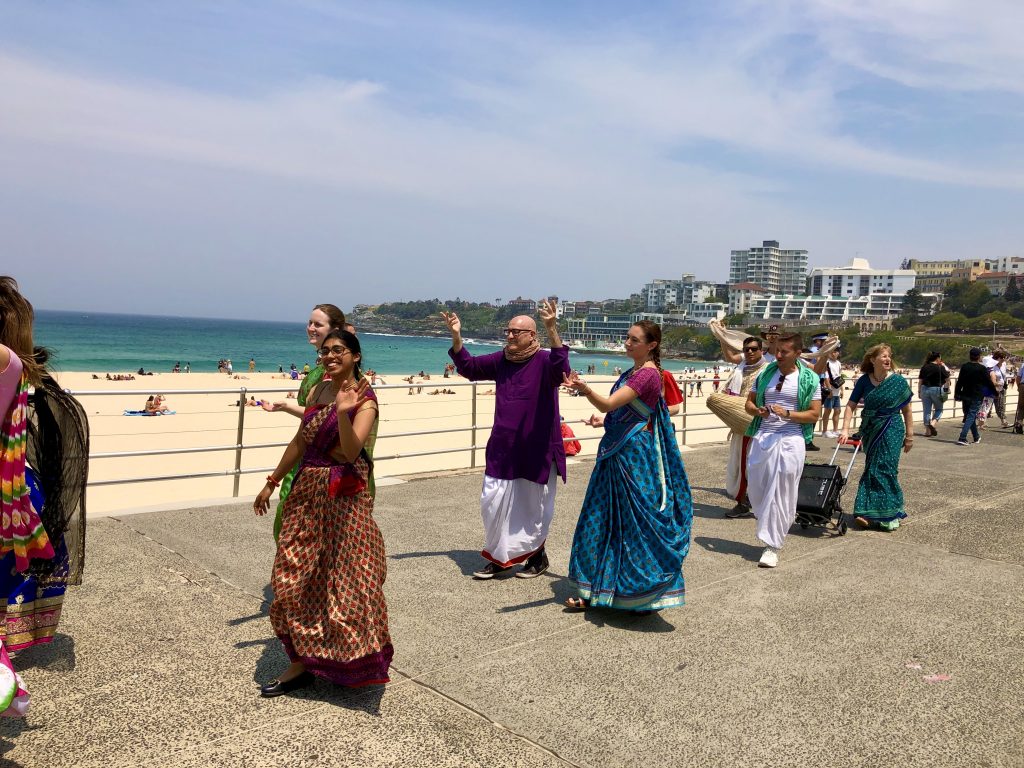Saturday, October 26th, 2019
When we are criticized, is defending ourselves detrimental for our bhakti?
→ The Spiritual Scientist
Answer Podcast
The post When we are criticized, is defending ourselves detrimental for our bhakti? appeared first on The Spiritual Scientist.
Srila Gaura-Kisora Dasa Babaji
→ Dandavats
 By Chandan Yatra Das
By Chandan Yatra DasSrila Gaura-Kisora dasa Babaji was a renunciation personified. He had very few possessions: Tulasi-mala (Tulasi beads) around his neck; another Tulasi-mala on which he chanted; and a few books such as Narottama Dasa Thakura's Prarthana and Prema Bhakti Chandrika. He refused service from anyone and would not let anyone serve him, though many tried Continue reading "Srila Gaura-Kisora Dasa Babaji
→ Dandavats"
Bondi Beach Harinama
→ Ramai Swami


The devotees in Sydney regularly go out on Harinamas all over the city and suburbs. These are organised by the North Sydney temple, western suburbs devotees and Govindas Asrama in Darlinghurst.
I was invited by my godbrother, Pratapana, to go to Bondi beach, which is famous in Australia. We went out on a Saturday afternoon and the beach was crowded with locals, people from the suburbs and tourists from overseas.
Many people clapped and danced to the kirtan, with some even joining in feeling the ecstasy of the holy name.


One Who Loves God Must Love Everybody
Giriraj Swami
 At a lecture that Srila Prabhupada gave on April 6, 1972, at Tarrawarra Abbey, in Melbourne, one of the members said to Prabhupada, “Swami, in the Christian history, one of the people that many of us look up to is a man called Francis of Assisi, and he talks about knowing God, and he rates it up with experiences such as on the occasion when he embraced a leper. And he says, ‘If we turn away from our fellow, then we are not reaching God, or God consciousness.’ And this is in line with one of the central teachings of the Christian scriptures, which is that if any man says he loves God and does not love his neighbor, then that man is a liar.”
At a lecture that Srila Prabhupada gave on April 6, 1972, at Tarrawarra Abbey, in Melbourne, one of the members said to Prabhupada, “Swami, in the Christian history, one of the people that many of us look up to is a man called Francis of Assisi, and he talks about knowing God, and he rates it up with experiences such as on the occasion when he embraced a leper. And he says, ‘If we turn away from our fellow, then we are not reaching God, or God consciousness.’ And this is in line with one of the central teachings of the Christian scriptures, which is that if any man says he loves God and does not love his neighbor, then that man is a liar.”
“If actually one loves God,” Prabhupada replied, “he must love everybody. That is the sign. Just like my mouth is now thirsty. I am quenching with drinking water and putting here. As soon as I put the water here, immediately the energy is distributed all over the body. So a God conscious person cannot be neglectful or envious of anyone. That is the test. Sarvair gunais tatra samasate surah (SB 5.18.12). [All the demigods and their exalted qualities, such as religion, knowledge, and renunciation, become manifest in the body of one who has developed unalloyed devotion for the Supreme Personality of Godhead.] All good qualities. So, this is a good quality—to love your neighbor, to give them service. So, if a person is actually God conscious, he must be sympathetic with the troubles of his neighbor, or anyone—not only human beings, animals also. They are also living entities. A God conscious person makes no discrimination between human being and animal or trees or plants, because they are also living entities.”
Hare Krishna.
Yours in service,
Giriraj Swami
Darshan of Yamuna and Yamaraja (Album of photos)
→ Dandavats

Darshan of Yamuna and Yamaraja (Album of photos)
Bhakti Chaitanya Swami: Some photos from our parikrama yesterday. It was the first day of our Vraja Mandala parikrama, so we began by taking bath at Vishram Ghat in Mathura, and then had darshan of Yamuna and Yamaraja, and then the two Varaha Deities nearby
Karttika is a sale like Black Friday. Everything is given away for nothing!
→ Dandavats

Kadamba Kanana Swami: Kunti was so interested in Krishna she did not care about anything else. She said, “My Lord, Your Lordship can easily be approached, but only by those who are materially exhausted. One who is on the path of [material] progress, trying to improve himself with respectable parentage, great opulence, high education and bodily beauty, cannot approach You with sincere feeling.” (SB 1.8.26)
Read More...Kanak Vrindavan (Album of photos)
→ Dandavats

Kanak Vrindavan (Album of photos)
Indradyumna Swami: During our Kartika parikrama in Jaipur we visited Kanak Vrindavan where Radha Madhava, the original deities of Jayadeva Goswami, are worshipped. We relished hearing from Mukunda Datta prabhu about the history of Kanak Vrindavan, as well as his comments on the Gita Govinda written by Jayadeva Goswami. We also appreciated the beautiful gardens and old architecture that make Kanak Vrindavan so famous.
Day 3-5 – Braja Parikrama 2019
→ KKSBlog

Jaipur trip
Day 3, 4 and 5 takes us out of Vrindavan and to the city of Jaipur in Rajasthan. This 3-day trip passes through Karoli in the search for the original deities (Radha Madan Mohan and Govindaji) of the Vrindavan temples that were moved during a Muslim invasion.
Videos
Videos from Karoli and Jaipur. If you cannot see the videos below go to our youtube channel.
Madan Mohan, Karoli
Govindaji
Gopinath Mandir
Morning class 5 nov Jaipur
Photos
Braja Parikrama 2019 Schedule
- 1st Nov – Govinda kund, Tribhuvanatha Samadhi, Nrsimha temple Puncari
- 2nd Nov – Gosvami Temples Vrindavana
- 3-5 Nov Jaipur
- 6th Nov – Yavat, Vrindakund
- 7th Nov – Sanket, Anjanoka
- 8th Nov – Vrindavan Parikrama
- 9th Nov – Unchagaon
- 10th Nov – Rest
- 11th Nov – Kamyavan
- 12th Nov – Garuda Govinda, Rama Tala
The article " Day 3-5 – Braja Parikrama 2019 " was published on KKSBlog.
The mantra to attain perfection in our chanting
→ Dandavats

The mantra to attain perfection in our chanting. Krishna is self-sufficient because all the ingredients for creation are within Himself. First Krishna creates time, for without time there cannot be a beginning of anything. Sukadeva Goswami speaks to Maharaja Pariksit Krishna’s pastimes to bring Him to the point of complete resolute faith and absorption in Krishna.
Read More...
A visit to the ISKCON Temple Guest House Vrindavan – Shri Krishna Balaram Mandir Darshan
→ Dandavats
 By Arti
By Arti I do not know if the Krishna Balaram ISKCON temple in Vrindavan is among the best ISKCON Temples in the world or not but after having spent a few days here, I can say that it is definitely one of the best. A must-visit for every devotee visiting Vrindavan, it is not to be missed for anything! Built in an ornate architectural manner, the temple was inaugurated by His Divine Grace A. C. Bhaktivedanta Swami Srila Prabhupada, Founder Acharya of the International Society for Krishna Consciousness (ISKCON) in the year 1975. Spread in a huge expanse, the ISKCON complex today houses a guest house, Govinda’s restaurant, a bakery, a gift shop, Prabhupadji’s house/ museum and his Samadhi Mandir besides the main temple hall. Continue reading "A visit to the ISKCON Temple Guest House Vrindavan – Shri Krishna Balaram Mandir Darshan
→ Dandavats"
Why do we feel insecurity?
→ The Spiritual Scientist
How to stop overthinking -Attribute, Analyze, Anchor, Act
→ The Spiritual Scientist
Podcast
Podcast Summary
Video:
The post How to stop overthinking -Attribute, Analyze, Anchor, Act appeared first on The Spiritual Scientist.
Srila Prabhupada – The transcendentalist who embodied the best of traditionalist, existentialist and utopianist
→ The Spiritual Scientist
[Prabhupada disappearance day celebration at Fort Lauderdale, USA]
Podcast
Podcast Summary
Video:
The post Srila Prabhupada – The transcendentalist who embodied the best of traditionalist, existentialist and utopianist appeared first on The Spiritual Scientist.
Damodarashtakam 4 – Seeing God as the supreme desirable, not just as the source of all desirables
→ The Spiritual Scientist
[Talk at Fort Lauderdale, USA]
Podcast
Podcast Summary
icon
Video:
The post Damodarashtakam 4 – Seeing God as the supreme desirable, not just as the source of all desirables appeared first on The Spiritual Scientist.
Gopastami
Giriraj Swami
 Today is Gopastami, the day on which Krishna and Balarama and other boys Their age, who previously had tended the calves, were given charge of the cows. This event is described in Srimad-Bhagavatam (10.15.1):
Today is Gopastami, the day on which Krishna and Balarama and other boys Their age, who previously had tended the calves, were given charge of the cows. This event is described in Srimad-Bhagavatam (10.15.1):
tatas ca pauganda-vayah-sritau vraje
babhuvatus tau pasu-pala-sammatau
gas carayantau sakhibhih samam padair
vrndavanam punyam ativa cakratuh
“When Lord Rama and Lord Krsna attained the age of pauganda [six to ten] while living in Vrndavana, the cowherd men allowed Them to take up the task of tending the cows. Engaging thus in the company of Their friends, the two boys rendered the land of Vrndavana most auspicious by imprinting upon it the marks of Their lotus feet.”
As stated in the purport, “Since Lord Krsna’s spiritual body had apparently grown slightly in age and strength, the senior men of Vrndavana, headed by Nanda Maharaja, decided to promote Krsna from the task of herding calves to the status of a regular cowherd boy. He would now take care of the full-grown cows, bulls, and oxen. Out of great affection, Nanda Maharaja had previously considered Krsna too small and immature to take care of full-grown cows and bulls. It is stated in the Karttika-mahatmya section of the Padma Purana:
suklastami karttike tu
smrta gopastami budhaih
tad-dinad vasudevo ’bhud
gopah purvam tu vatsapah
‘The eighth lunar day of the bright fortnight of the month of Karttika is known by authorities as Gopastami. From that day, Lord Vasudeva served as a cowherd, whereas previously He had tended the calves.’
“The word padaih indicates that Lord Krsna blessed the earth by walking on her surface with His lotus feet. The Lord wore no shoes or other footgear but walked barefoot in the forest, giving great anxiety to the girls of Vrndavana, who feared that His soft lotus feet would be injured.”
On this occasion, in temples in Vrindavan and elsewhere, Srimati Radharani is dressed as a cowherd boy—Subala.
Hare Krishna.
Yours in service,
Giriraj Swami
The Auspicious Month of Kartik, November 3, Dallas
Giriraj Swami
Posted by Giriraj Swami on Sunday, November 3, 2019
Yoga Society of Greater Dallas, November 2, Dallas
Giriraj Swami
 “The Lord created this material world to enable the conditioned souls to learn how to perform yajnas (sacrifices) for the satisfaction of Vishu, so that while in the material world they can live very comfortably without anxiety, and after finishing the present material body they can enter into the kingdom of God. That is the whole program for the conditioned soul. By performance of yajna, the conditioned souls gradually become Krishna conscious and become godly in all respects. In the Age of Kali, the sankirtan-yajna (the chanting of the names of God) is recommended by the Vedic scriptures, and this transcendental system was introduced by Lord Caitanya for the deliverance of all men in this age. Sankirtan-yajna and Krishna consciousness go well together.”—Bhagavat-gita 3.10 purport.
“The Lord created this material world to enable the conditioned souls to learn how to perform yajnas (sacrifices) for the satisfaction of Vishu, so that while in the material world they can live very comfortably without anxiety, and after finishing the present material body they can enter into the kingdom of God. That is the whole program for the conditioned soul. By performance of yajna, the conditioned souls gradually become Krishna conscious and become godly in all respects. In the Age of Kali, the sankirtan-yajna (the chanting of the names of God) is recommended by the Vedic scriptures, and this transcendental system was introduced by Lord Caitanya for the deliverance of all men in this age. Sankirtan-yajna and Krishna consciousness go well together.”—Bhagavat-gita 3.10 purport.
Bhagavat-gita 3.10 (Right click to download)
Brazil’s Radha Krishna Camp to Immerse Youth in Spiritual Fun
→ ISKCON News
Caribbean Tour to Inspire Youth in Krishna Consciousness
→ ISKCON News

For the past twenty-five years, ISKCON Youth Ministry’s Manorama Das and his wife Jaya Sri Radhe Dasi have taken youth on tours across the US, Canada and Mexico, where they spread Krishna consciousness and get inspired themselves in the process. Since 2015, they’ve branched out to tour the Caribbean every two years.
Day 2 – Braj Parikrama 2019
→ KKSBlog

Gosvami temples in Vrndavana
The second day of the Braj Parikrama 2019 takes us around Vrndavana to visit the temples of the six gosvamis; Imli Tal, Sri Sri Radha Gokulananda & Sri Sri Radha Madan Mohan.
Videos
Below are the links to live videos. If you cannot see the videos below visit our FB page or our Youtube channel.
Madana Mohan temple
Imli Tal
Radha Gokulananda
Photos
Braja Parikrama 2019 Schedule
- 1st Nov – Govinda kund, Tribhuvanatha Samadhi, Nrsimha temple Puncari
- 2nd Nov – Gosvami Temples Vrindavana
- 3-5 Nov Jaipur
- 6th Nov – Yavat, Vrindakund
- 7th Nov – Sanket, Anjanoka
- 8th Nov – Vrindavan Parikrama
- 9th Nov – Unchagaon
- 10th Nov – Rest
- 11th Nov – Kamyavan
- 12th Nov – Garuda Govinda, Rama Tala
The article " Day 2 – Braj Parikrama 2019 " was published on KKSBlog.
Future of Cow Care in Iskcon (video) Oct 4, 2019 New Vrindaban – 3rd North American Farm Conference
→ Dandavats

Future of Cow Care in Iskcon (video)
Syamasundara is the manager of the goshala (cow sanctuary) at Bhaktivedanta Manor in England since 1993. Syamasundar Das arranged with European devotees and founded the Farm Conference circuit which is now on its 3rd year. In this discussion, he expounds on the future of cow protection in North America and the resolutions the GBC is making for the production of offered milk to the deities
The Most Beautiful Radha Gopinath (Album of photos)
→ Dandavats

The Most Beautiful Radha Gopinath (Album of photos)
Indradyumna Swami: Today in Jaipur our Kartika parikrama party visited the temple of Radha Gopinath. The deity of Gopinath was carved over 5,000 years ago and remains a source of great inspiration for all Gaudiya Vaisnavas. Gopinath means, Lord of the Gopis. The temple is famous for it’s groups of women who sit for hours each day in front of the deities singing devotional songs. Our parikrama party also visited the famous Amber Fort, high on a hill on the outskirts of the city. While there we had an enthusiastic kirtan for all to see.
Alachua’s Hare Krishna Social Services. Disability/Accessibility Task Force
→ Dandavats

Alachua’s Hare Krishna Social Services. Disability/Accessibility Task Force.
Last week, the first meeting of the Disability /Accessibility Task Force was held. These devotees, in partnership with Don Barnes from the Center for Independent Living, looked at various obstacles facing devotees and guests with mobility or other health issues. The goal is to make the temple property more welcoming for those with varying levels of ability.
Mother Cow Dairy News!
→ Dandavats

Mother Cow Dairy News!
Krishnarupa devi dasi: A group of devotees in Melbourne have arrived at an amazing initiative, under the guidance of His Holiness Bhakti Rasamrita Swami, to supply ahimsa milk in commercial quantities.
A visit to the Bhaktivedanta Manor 20-acre farm
→ Dandavats

A visit to the Bhaktivedanta Manor 20-acre farm.
Karunamayi dasi: On my recent trip back to the UK, I had the opportunity to visit the Bhaktivedanta Manor 20-acre farm. Sanj, who has been on the team for six years, gave me a tour of their pasture. During the excursion, I noticed many similarities to the New Govardhana goshala and its cow protection program.
Happy Gopastami!
→ Mayapur.com
Krishna, the Supreme Cowherd Boy suklastami karttike tu smrta gopastami budhaih tad-dinad vasudevo ‘bhud gopah purvam tu vatsapah “The eighth lunar day of the bright fortnight of the month of Kartik is known by authorities as Gopastami. From that day, Lord Vasudeva served as a cowherd, whereas previously He had tended the calves.” -Srimad Bhagavatam […]
The post Happy Gopastami! appeared first on Mayapur.com.
Request for prayers
→ Dandavats
 BB Govinda Swami: Dear friends, an old disciple of Srila Prabhupada named Bhagavan dasa is having a kidney transplant operation today. May I request all of my friends to say a prayer to Radhe Shyam for his protection.
BB Govinda Swami: Dear friends, an old disciple of Srila Prabhupada named Bhagavan dasa is having a kidney transplant operation today. May I request all of my friends to say a prayer to Radhe Shyam for his protection.Jaya Gauranga dasa’s Housewarming, November 3, Dallas
Giriraj Swami
Posted by Giriraj Swami on Sunday, November 3, 2019
Audio
Srimad-Bhagavatam 7.5.12 (Right click to download)
Unity in Variety, November 2, Dallas
Giriraj Swami
 Giriraj Swami read and spoke on Srimad-Bhagavatam 7.5.12.
Giriraj Swami read and spoke on Srimad-Bhagavatam 7.5.12.
“As members of ISKCON we all under the authority of Srila Prabhupada. We can serve Srila Prabhupada according to our individuality. But, the definition of devotional service is that it must be anukul—it must be favorable—and for our service to be favorable we have to know what the master wants. We cant offer the master something the master doesn’t want under the plea that that is my individuality because that is a false conception of individuality. So, the first thing is Srila Prabhupada is the master and we need to know what the master wants. As long as we give him something that he wants then we are all right. We are not all going to offer the same thing but it is all within the range of what the master wants.”
Unity in Variety (Right click to download)
New Book: Leadership Lessons from the Bhagavad Gita
→ ISKCON News

A new book ‘Leadership Lessons from the Bhagavad Gita’ wonderfully combines the two worlds of management and spirituality. The author Ace V. Simpson, a.k.a. Shri Prahlada Das is a well-known kirtaniya from Australia, but he is also a scholar with a Ph.D. and now teaches at Brunel Business School in London, UK.
A Final Lesson
→ ISKCON News
Remembering Srila Prabhupada on His Disappearance Days
→ ISKCON News
Day 1 – Braj Parikrama 2019
→ KKSBlog

Govinda kund and Nrsimhadeva temple in Govardhana
The first day of Braj Parikrama 2019 with Kadamba Kanana Swami has started and this first trip takes us to Govardhana, Govinda kund and the Nrsimhadeva temple.
Govinda Kund
Below are the links to live videos from Day 1. If you cannot see the videos below visit our FB page. Stay tuned for more recordings and videos on our Youtube channel.
Nrsimhadeva temple
Bhajans @ Srila Prabhupada’s room
Photos
A small peek into the trip to Govardhana, Govinda kund and the Nrsimhadeva temple. Photos by Svasti-Gopinatha, Tamala Krsna, Gauravani and others.
Braj Parikrama 2019 Schedule
- 1st Nov – Govinda kund, Tribhuvanatha Samadhi, Nrsimha temple Puncari
- 2nd Nov – Gosvami Temples Vrindavana
- 3-5 Nov – Jaipur
- 6th Nov – Yavat, Vrindakund
- 7th Nov – Sanket, Anjanoka
- 8th Nov – Vrindavan Parikrama
- 9th Nov – Unchagaon
- 10th Nov – Rest
- 11th Nov – Kamyavan
- 12th Nov – Garuda Govinda, Rama Tala
The article " Day 1 – Braj Parikrama 2019 " was published on KKSBlog.
A Victorious City (Album of photos)
→ Dandavats

A Victorious City (Album of photos)
Indradyumna Swami: This weekend our parikrama party is visiting Jaipur, in Rajasthan. Here we find beautiful Sri Sri Radha Govinda, the worshipable Deities of Srila Rupa Goswami. Each morning thousands of citizens literally run to Their mangala arotika and sing Their praises for hours. Many return to the temple in the evening as well. These Deities are literally the center of people’s lives here. And the devotion of the citizens is contagious! We look forward to our 4 days here in the “City Of Victory!”
One of the best decoration resembling Lord Indra’s torrential rains (4 min. video)
→ Dandavats

One of the best decoration resembling Lord Indra’s torrential rains on Govardhana at the Temple of Sri Sri Gaura Nitai (Kharkiv, Ukraine)(4 min. video)
Meet His Grace Alalanatha dasa a long-time devotee and member of the New Govardhana community in Australia
→ Dandavats

Meet His Grace Alalanatha dasa a long-time devotee and member of the New Govardhana community in Australia.
Q: Please tell us a little bit about yourself. AD: I grew up in Western Australia. I was a keen surfer, traveler and spiritual seeker. In 1972, I visited the Sydney temple on my way overseas and began practicing Krishna consciousness. I was fortunate to be initiated by Srila Prabhupada and afterward I ceased traveling and moved into the temple. I served as a book distributor and fundraiser in Australia, New Zealand and Europe for five years. During the 1980s, I served as temple president of Christchurch temple for eight years and also at New Varshana, Auckland for two years.
ISKCON UK’S 50TH ANNIVERSARY
→ Dandavats

ISKCON UK’S 50TH ANNIVERSARY
The first ISKCON members to enter Britain in 1968 were three young American husband and wife teams, Malati devi and Shyamasundara dasa; Mukunda dasa and Janaki dasi; and Yamuna devi and Garuda dasa. At first, not having any financial support meant life was a struggle. Yet soon they gained the attention of one of The Beatles, George Harrison, who had encountered the Hare Krishna devotees in America. Together with John and Paul, they recorded a single of the maha-mantra, which reached the ‘Top of the Pops’.
Appearance day of Srila Gadadhara Pandita
→ Dandavats
 By Sri Kavi Karnapura
By Sri Kavi Karnapura Sri Kavi Karnapura states in Gaura Ganodessa Dipika that in Vraja lila Gadadhara Pandit is the daughter of King Vrsabhanu-Srimati Radharani. Gadadhara Pandit served as Lord Gaura's chief assistant during His Navadvipa-lila. Sri-Sri Radha Krishna in Vrndavana appear as Gaura-Gadadhara to perform pastimes in Navadvipa in the forest groves beside the Ganges. Continue reading "Appearance day of Srila Gadadhara Pandita
→ Dandavats"
Ramayana Sites in Sri Lanka
→ Stephen Knapp
The Kidnapping of Sita by Ravana
Sita Taken from Sita Kotuwa to Ashok Vatika (also known as Ashoka / Asoka Vanam)
Search for Sita
Hanuman meets Sita at Ashok Vatika and is Captured by Ravana
Sita is Hidden after the visit of Hanuman
Upon hearing Hanuman’s threat and seeing his capabilities, King Ravana decided to hide Sita at various secret locations as a precautionary measure. Ravanagoda, which means Ravana’s place in the Kotmale area, is one such complex of tunnels and caves.
Preparing for Battle
War Breaks Out
The Fall of Ravana
After the War

































































